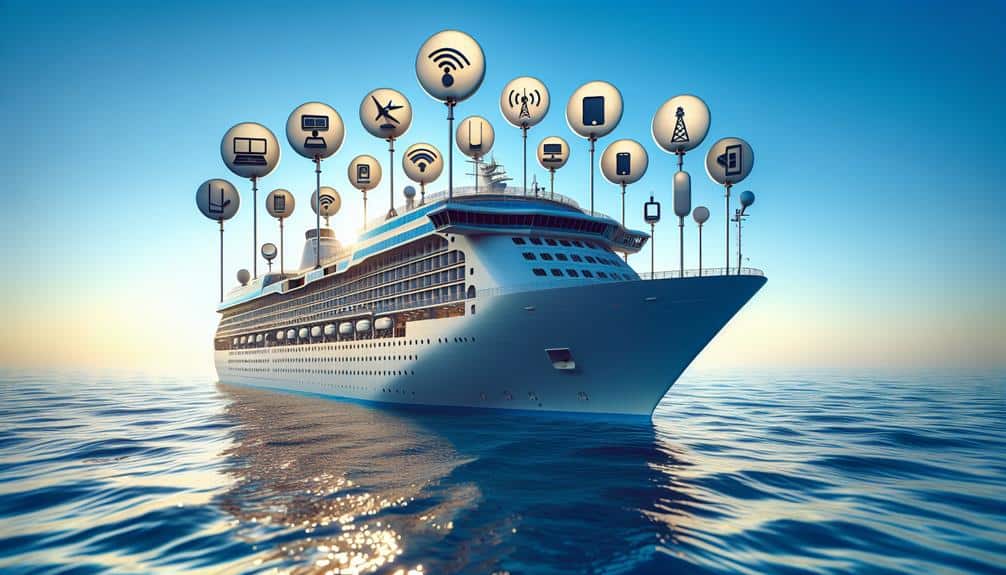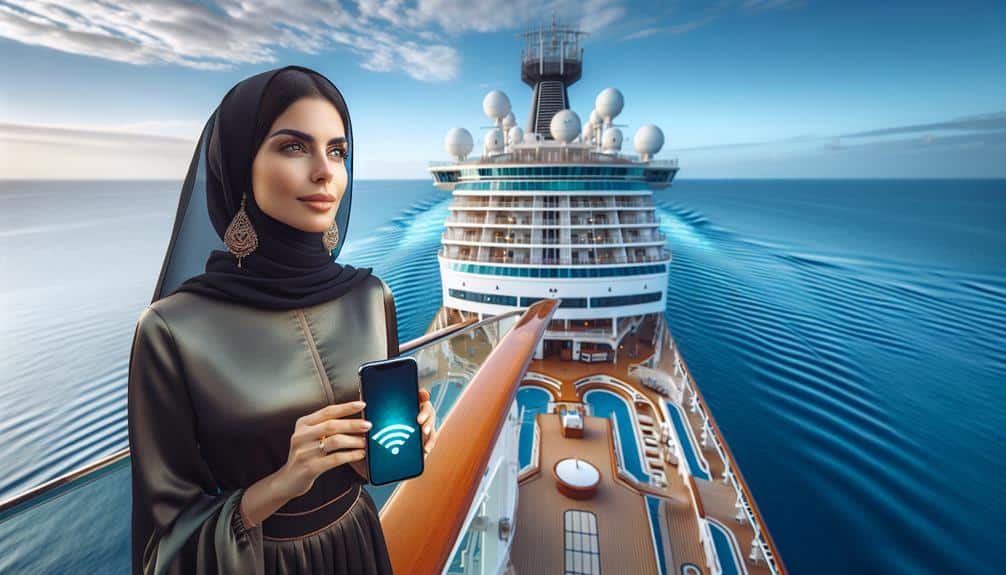When on a cruise ship, internet speed is slow due to satellite challenges like moving ships and weather inconsistencies. Bandwidth is limited at sea, causing congestion and reduced speeds. A high number of users strain the network, making bandwidth-intensive activities worse. The ship's location impacts connectivity as regions and weather affect signal strength. Technical constraints like latency and bandwidth management also play a role. Understanding these factors is essential for managing expectations. Understanding these factors is vital for managing expectations.
Key Points
- Satellite coverage challenges due to ship movement and weather affect signal consistency.
- Bandwidth limitations from satellite congestion and weather disruptions decrease internet speeds.
- High number of users on ships strain bandwidth, worsening network congestion.
- Ship's location impacts connectivity quality with varying weather conditions affecting signal strength.
- Technical infrastructure constraints like latency and bandwidth management influence internet speed.
Satellite Internet Challenges
Traversing the vast expanse of satellite internet challenges onboard cruise ships requires a deep understanding of the intricacies involved in maintaining a stable connection at sea. Satellite coverage plays an important role in providing internet connectivity to cruise ships as they sail through remote areas. However, this coverage can be inconsistent due to the ship's movement and the obstructive nature of certain weather conditions. Signal interference, caused by factors such as inclement weather, geographical location, and physical obstacles onboard the ship, can impact the quality of the connection.
To combat these challenges, cruise ships are equipped with advanced satellite communication systems that can adjust to varying signal strengths and frequencies. Engineers work tirelessly to optimize these systems to minimize signal interference and guarantee a more reliable internet connection for passengers. Additionally, the strategic placement of satellite antennas on the ship can help mitigate disruptions caused by obstacles onboard or external factors. Understanding the complexities of satellite coverage and signal interference is essential for overcoming internet challenges at sea.
Bandwidth Limitations at Sea
How do bandwidth limitations impact internet speed at sea for cruise ship passengers?
Bandwidth limitations at sea are primarily influenced by satellite coverage and weather conditions. Satellite internet is the main source of connectivity for most cruise ships, and the bandwidth available is shared among all users onboard. The limited number of satellites covering the vast ocean expanse can lead to congestion and reduced speeds during peak usage times. Additionally, inclement weather, such as heavy rain or storms, can disrupt the satellite signal, further impacting internet speed.
Satellite coverage plays an important role in determining the quality of internet service onboard. Ships must rely on satellites for connectivity, and the number of satellites available to serve a specific area can affect the bandwidth allocated to each ship. Weather conditions also pose a challenge, as satellite signals can be weakened or interrupted by adverse weather, causing fluctuations in internet speed for passengers.
Understanding these bandwidth limitations is essential for cruise ship operators and passengers to manage expectations regarding internet connectivity at sea.
High Number of Users
The significant number of users on a cruise ship can greatly impact internet speed for passengers. When a high volume of passengers simultaneously connects to the ship's network, network congestion occurs due to the limited bandwidth available. This congestion leads to slower internet speeds and reduced quality of service for all users onboard.
User demand plays a vital role in exacerbating network congestion. As more passengers engage in bandwidth-intensive activities like streaming videos, video calling, or online gaming, the available bandwidth gets distributed among a larger number of users, resulting in decreased speeds for each individual user. The continuous demand for data-intensive applications further strains the network infrastructure, making it challenging for passengers to enjoy a seamless online experience.
To mitigate the effects of high user demand and network congestion, cruise lines are continuously investing in upgrading their onboard network infrastructure. By increasing overall bandwidth capacity and implementing advanced network management techniques, cruise operators aim to provide a more satisfactory internet experience for passengers despite the challenges posed by the high number of users onboard.
Ships Location Impact
Traversing through diverse geographic regions, cruise ships face varying challenges in maintaining consistent internet connectivity due to their changing locations. The impact of a ship's location on internet speed is significant.
Weather conditions play an important role in affecting signal strength. Storms, heavy rainfall, or even dense fog can interfere with satellite signals, leading to disruptions in the internet connection.
Navigation systems on cruise ships also influence internet speed. These systems require a stable and reliable connection to function correctly. If the internet connection is weak or unstable due to the ship's location, it can affect the performance of the navigation systems, potentially compromising the safety and efficiency of the voyage.
As a result, the geographical position of a cruise ship is a critical factor in determining the quality of internet service onboard. Sailing through different regions with varying weather conditions poses a continuous challenge for maintaining a stable and fast internet connection for passengers and crew.
Technical Infrastructure Constraints
Managing the intricacies of technical infrastructure constraints onboard cruise ships demands careful planning and strategic allocation of resources to guarantee excellent internet speed and connectivity for both passengers and crew members.
- Network Optimization
- Implementing advanced network optimization techniques can help streamline data flow and enhance overall internet performance.
- Latency Reduction
- Reducing latency is essential for ensuring a smooth browsing experience by minimizing delays in data transmission.
- Bandwidth Management
- Efficiently managing bandwidth allocation among users onboard can prevent network congestion and maintain ideal internet speeds.
Frequently Asked Questions
Can Passengers Use Their Personal Devices to Access the Internet on Cruise Ships?
Yes, passengers can use their personal devices to access the internet on cruise ships. Device compatibility may vary, affecting connectivity. Data usage is typically subject to restrictions due to limited bandwidth availability.
Do Cruise Ships Offer Any Packages or Options for Passengers to Upgrade Their Internet Speed?
You can enhance your cruise ship internet experience by considering upgraded internet packages. These options can provide improved connection reliability, ensuring smoother browsing and communication during your voyage. Make the most of your online time at sea.
How Does Bad Weather or Rough Seas Affect the Internet Speed on Cruise Ships?
In rough seas, satellite connectivity on cruise ships can suffer due to movement affecting signal reception. Bandwidth limitations compound the issue, causing slower internet speeds as the system struggles to transmit data efficiently in challenging maritime conditions.
Are There Any Specific Times of Day When Internet Speed Is Faster or Slower on Cruise Ships?
During peak hours on cruise ships, internet speed tends to slow due to high demand. Latency patterns show fluctuations based on usage levels. Understanding these trends can help you plan your online activities for peak performance.
Do Cruise Ships Have Any Plans to Improve Their Internet Speed in the Future?
In the future, cruise ships plan to address connectivity challenges by incorporating advanced technology to enhance internet speeds. These improvements will provide passengers with faster and more reliable internet access while onboard.



